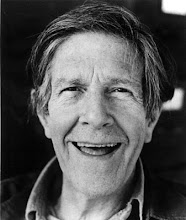 One of Cage's first mature visual artworks was "Not Wanting to Say Anything About Marcel" created in 1969. Reffering to Marcel Duchamp, an artist who rebelled against all established artistic conventions, helping to shape the anti-art, anti-aesthetic character of the Dada movement. Cage held a very similar devotion to idiosyncratic. and to chance. A very reoccuring key element in alot of Cages works.
One of Cage's first mature visual artworks was "Not Wanting to Say Anything About Marcel" created in 1969. Reffering to Marcel Duchamp, an artist who rebelled against all established artistic conventions, helping to shape the anti-art, anti-aesthetic character of the Dada movement. Cage held a very similar devotion to idiosyncratic. and to chance. A very reoccuring key element in alot of Cages works. The work is composed of two lithographs and a group of what he called plexigrams, silk screen printings on plexiglass panels. Each one of the individual panels consist of bits and pieces of words in all different fonts and sizes and fragmentsof words and individual letters, all which were goverened in chance operations and scattered in placement. meaning they were all chosen randomly with no premeditated thoughts. The colors of font are very minimal and limited in a pallete of shades of gray and black.

When first glancing at the piece it reminds me of the text filled pages of a magazine. With various words popping out some screaming out for attention more than others. The work appears to ve a simple 2 dimensional object having the text crammed in on a face of glass. but actually as you manipulate your viewing point from either side you get a whole different effect. The piece now becomes a 3 dimensional work and even creates a new image of waht you were seeing from straight ahead. All the word s that you were reading in a sequence now have altered. Other various words fragmented have appeared into your eyesightand others have hidden behind other fragments and create a new thought to the work. His intention of creating a 3 dimensional work gives the viewer this expierience and allows a sort of infinite possibilities to view. For instance if a tall man were to walk by and view this piece along side a shorter woman, they would both share an entirely different expierience in viewing. Both could be considered almoist viewing a whole different work in a sense.
"If something is boring after two minutes, try it for four. If still boring, then eight. Then sixteen. Then thirty-two. Eventually one discovers that it is not boring at all." This quote from Cage i believe relates well to his what may seem very minimal piece. In a way its like theres more than what the eye can see. At what may at first a muddy and distorted image to the eye, could very well become a lovely, poetic and sympathetical pieceof art. Sometimes it just takes a few moment to develop your thoughts and generate similarities to the work and your own personal life. Your reaction may not be immediate but more gradual as you expieriment with your perspective or angle you approach the work.



